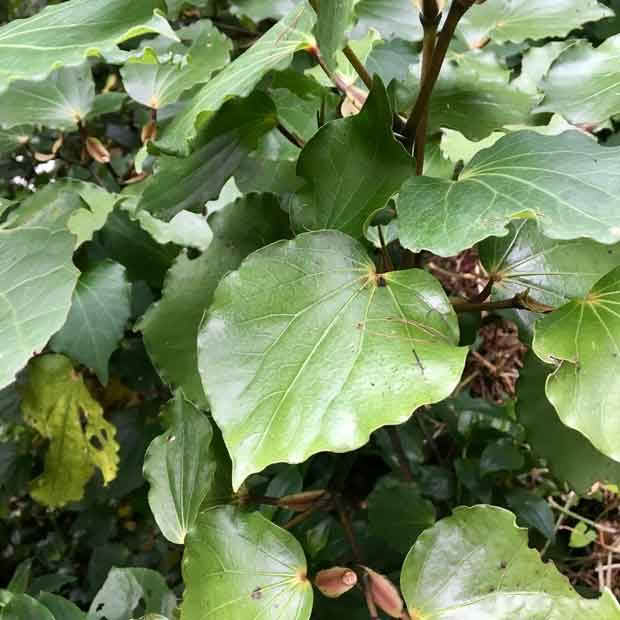Lucy Corry: The city dweller’s guide to foraging + how to make kawakawa vinegar
Even city dwellers can forage for edible finds with a few rudimentary guidelines to keep the tummy happy and the neighbours sweet, says Lucy Corry
Ask people to join you in a spot of urban foraging and reactions can be mixed. Some will think you’re inviting them to scrounge through rubbish bins. Others may accuse you of pinching from their gardens. The truly wise, however, will know that you’re referring to the ancient art of stalking edible plants usually in the wild but also in the sort-of wild, depending on where you live.

Kawakawa.
Parts of my own garden are so scary I daren’t venture into them alone, lest I fall prey to rampant tradescantia/wandering willy and convolvulus (neither of which can be safely eaten). In any case, there’s something about picking wild plants that speaks to my inner hunter-gatherer. When I was a child, my mother used to embarrass me by stopping to pick plants or flowers from reserves near where we lived. Now I’m the embarrassing mother, especially at this time of year, when you never know when you might come across a patch of just-ripe blackberries, a hillside covered in rambling nasturtiums or clumps of wild fennel, heavy with pollen.

Wild fennel.
Of course, if you live in an inner-city area or a brand-new subdivision, foraging opportunities may be limited. In that case, I’d suggest maintaining neighbourly relations and resisting the urge to reach over the fence and help yourself. Take care, too, when foraging in public spaces. My rule of thumb is to never pick anything at dog level, for reasons I hope are obvious, and I avoid anywhere that looks like it’s been sprayed. Also never eat anything you can’t identify, even if it looks familiar. Many years ago, when taking a night class in herbal medicine, one of my fellow students fell ill after brewing up a concoction from daisies growing on his lawn. Considering he’d mansplained everything consistently to the rest of us for the previous six weeks, none of us felt much sympathy.
Recently I had the great good fortune to meet Nikita Kusche, sous-chef at Hillside Kitchen & Cellar and foraging pro. Nikita has an innate sense of flavour, but generously says she learned everything she knows about foraging from Hillside’s head chef Max Gordy. Under his guidance, the small team at the much-awarded Thorndon restaurant often wanders around nearby Tinakori Hill to collect various edibles. Thanks to Nikita, I’m now looking at the wild parts of my garden – and the surrounding area – with fresh eyes. I just wish the giant spiders living in it wouldn’t look at me in the same way.

HOW TO MAKE KAWAKAWA VINEGAR
Kawakawa bushes of varying age and size have popped up all over my unruly garden, making them easy to harvest without leaving the perimeter. I mainly use them for tea but, after tasting Nikita’s kawakawa vinegar, I’m now hooked on making it myself.
Method: In the morning once the dew has dried off, pick about 25-30 leaves (traditional wisdom suggests picking leaves with holes in them; don’t pick young leaves or strip stems). Spread them out on a tray and leave for a few hours to make sure they’re dry (this also allows any bugs to wander out). Put the leaves in a jar and cover with 500ml apple cider vinegar. At this stage you can put the mixture in a blender and whiz, or just cover and allow the leaves to steep. The flavour will come through after just a few hours, but will intensify the longer you leave it. My current batch is two weeks old and is peppery, gingery and delicious.
I wouldn’t recommend drinking it neat, but you can add a tablespoon to a mug of freshly boiled water for an early morning pick-me-up, or use it in vinaigrettes, sauces or pickles. In winter, it’s good mixed with honey and ginger as a cold-weather tonic.

MORE BLOGS FROM LUCY
Lucy Corry’s Blog: Is there such thing as too much ice cream?

Lucy Corry is an award-winning food writer and is NZ Life & Leisure’s food editor. In her fortnightly blog Best Possible Taste she writes about her cooking experiments, kitchen hacks and New Zealand food issues. She loves bread, chocolate, wine and books (not necessarily in that order). Follow her on Instagram and on her blog The Kitchen Maid
MORE FORAGING IDEAS
Great Barrier Island herbal tonic business, Aotea, in growth mode
5 native plants to forage in New Zealand (and how to benefit from them)
Great Barrier Island herbal tonic business, Aotea, in growth mode
Great Barrier Island herbal tonic business, Aotea, in growth mode

